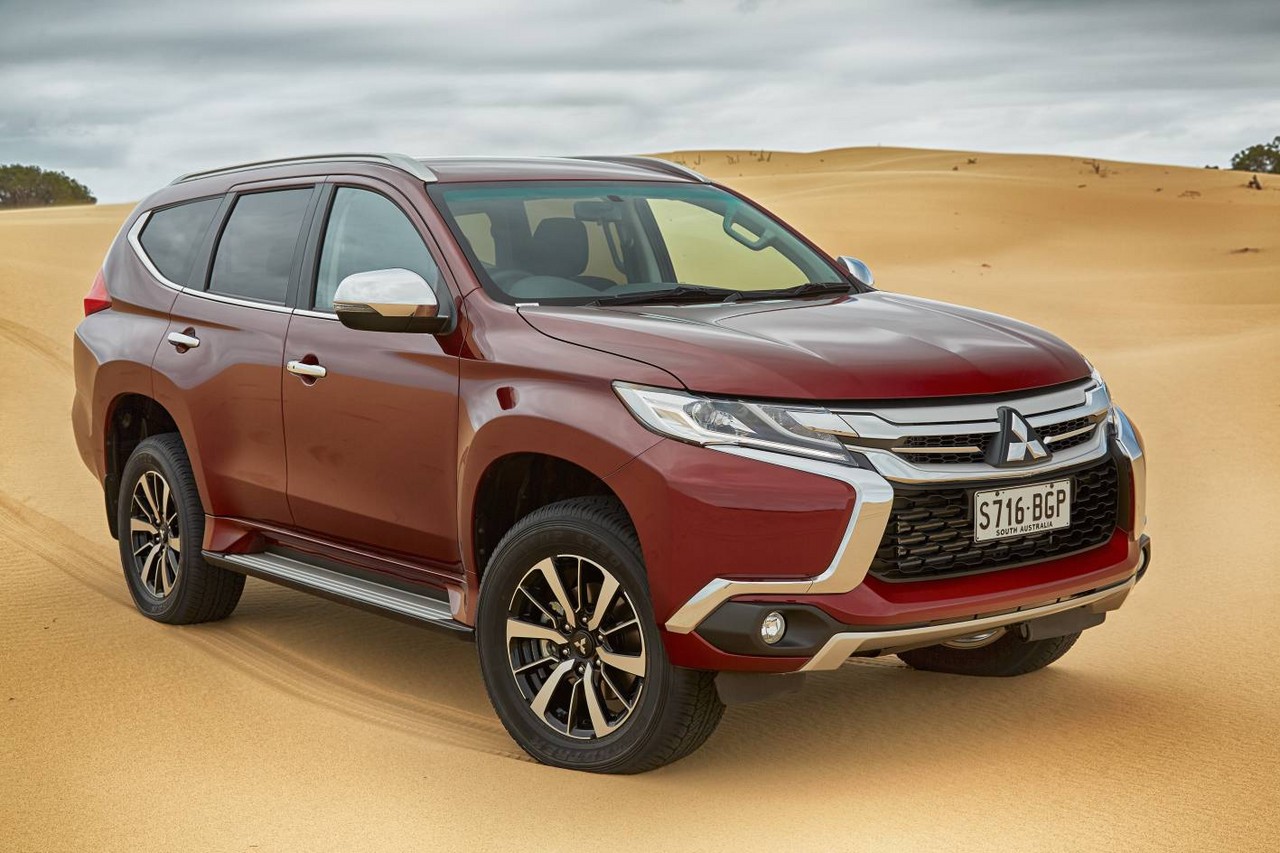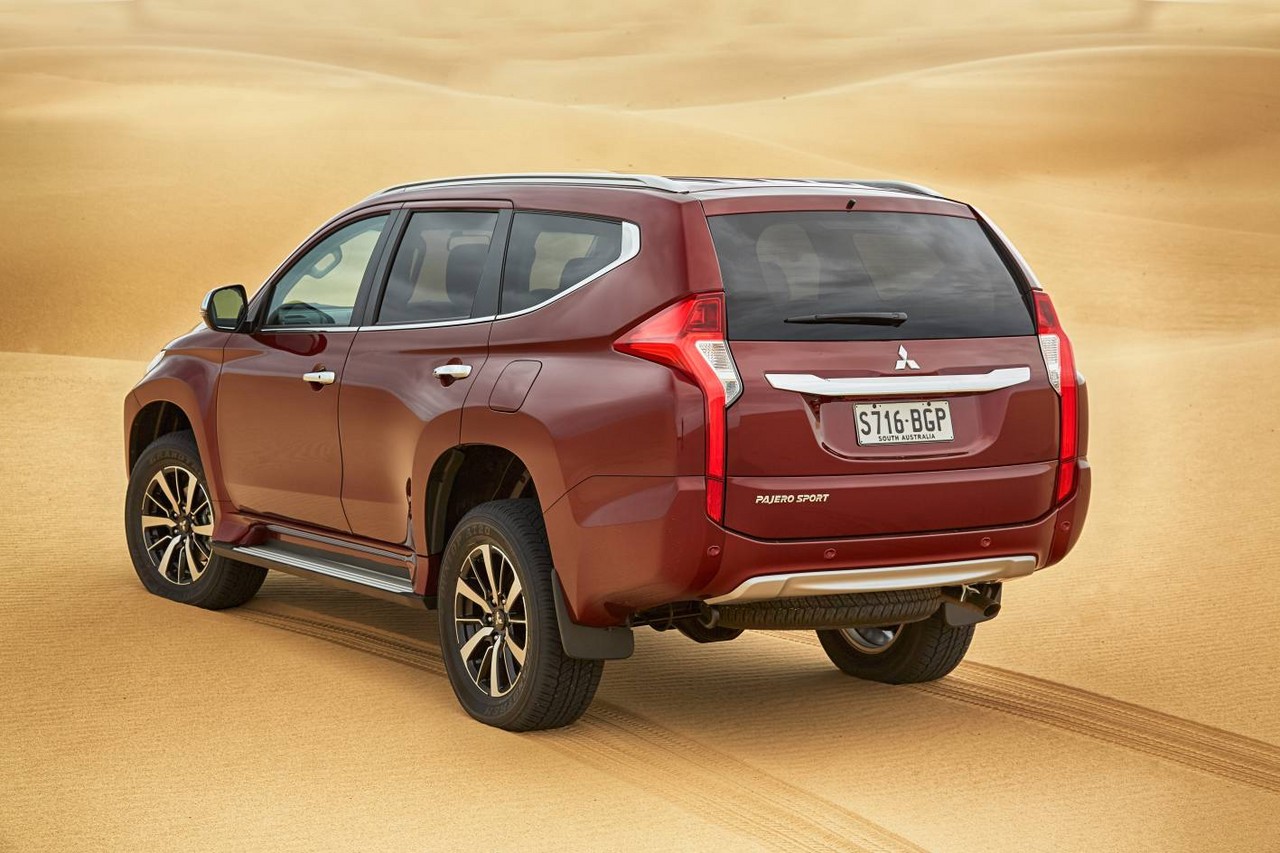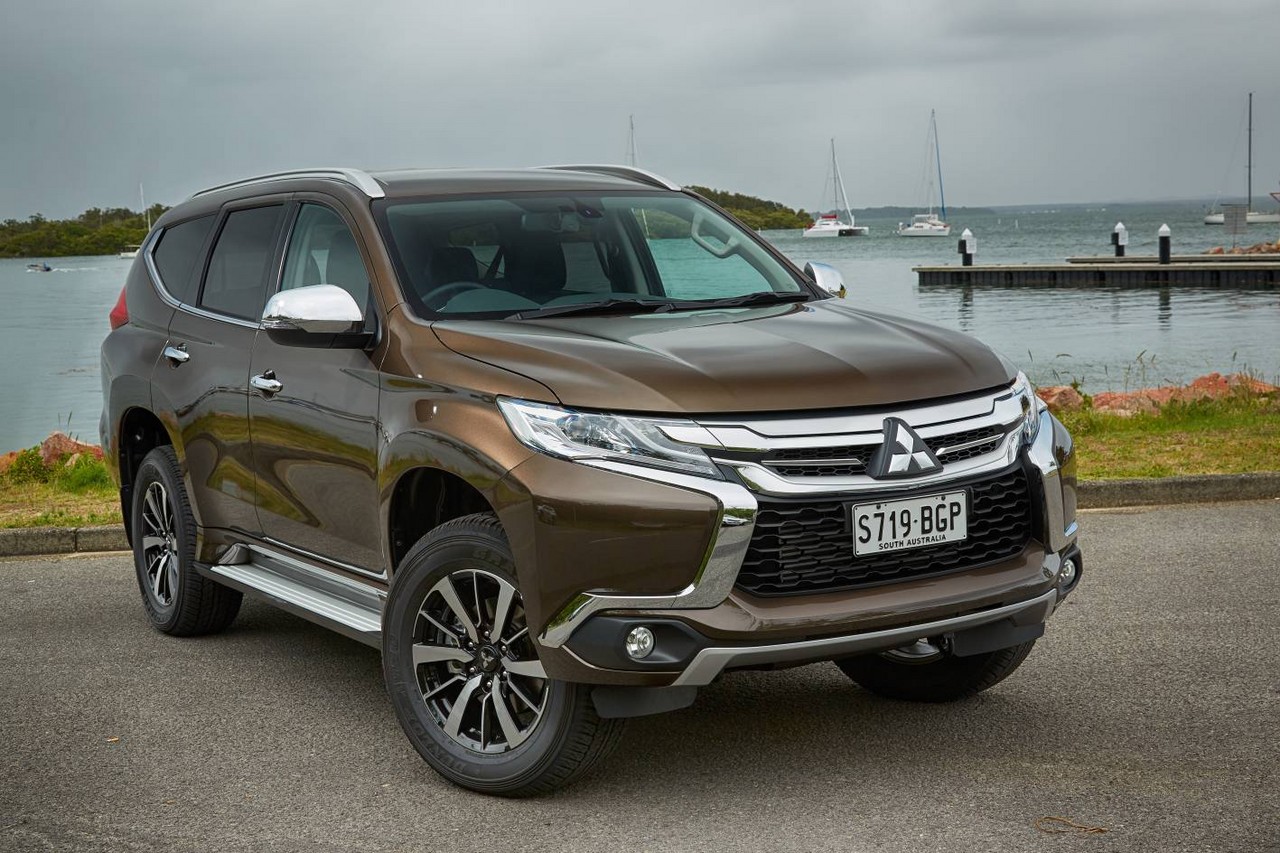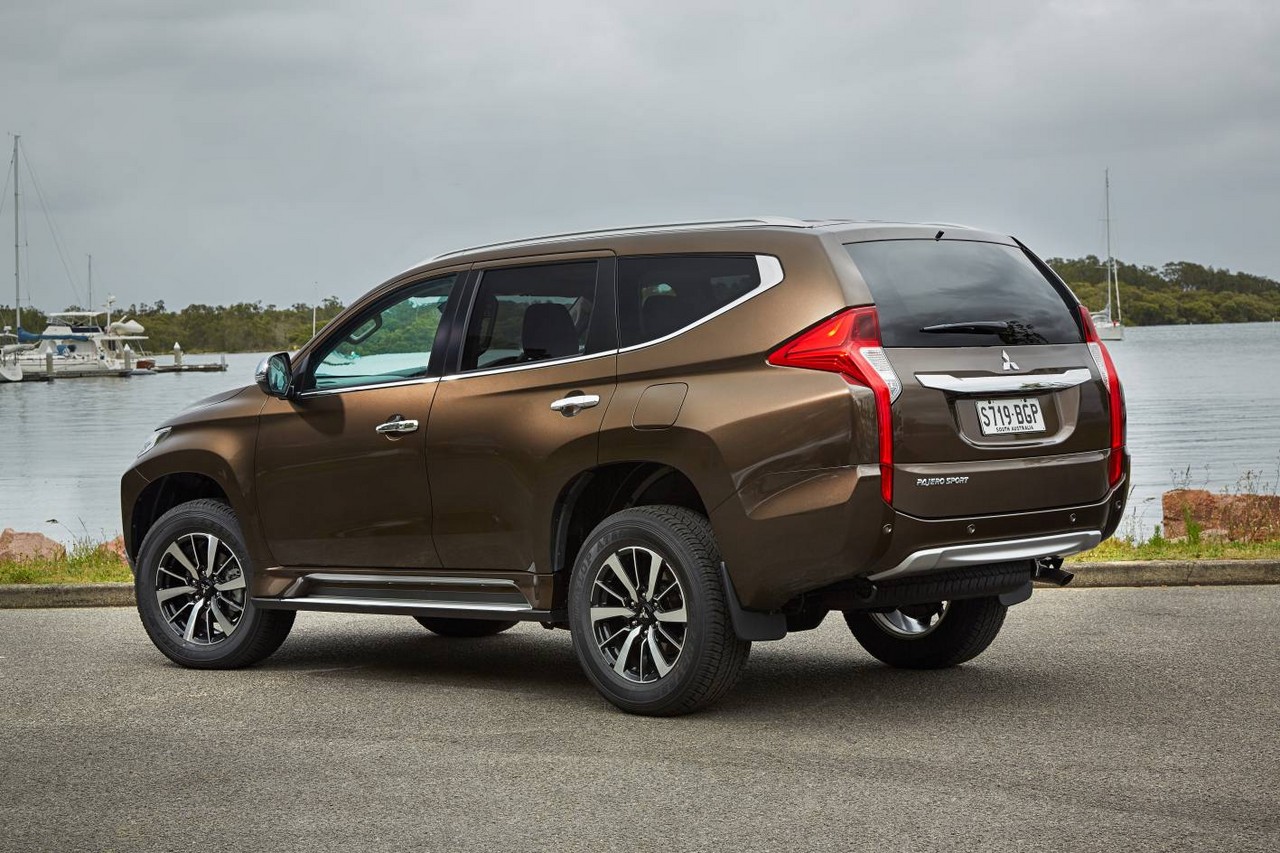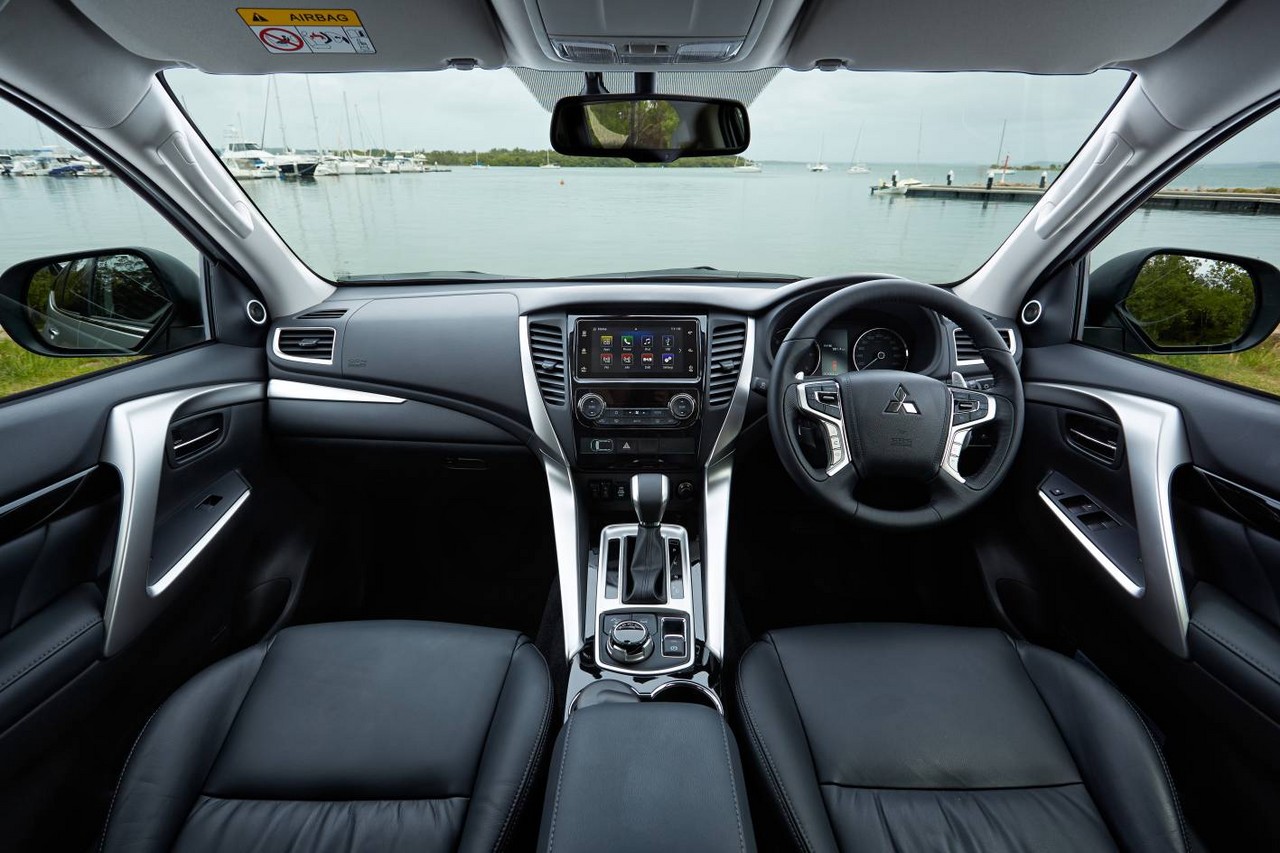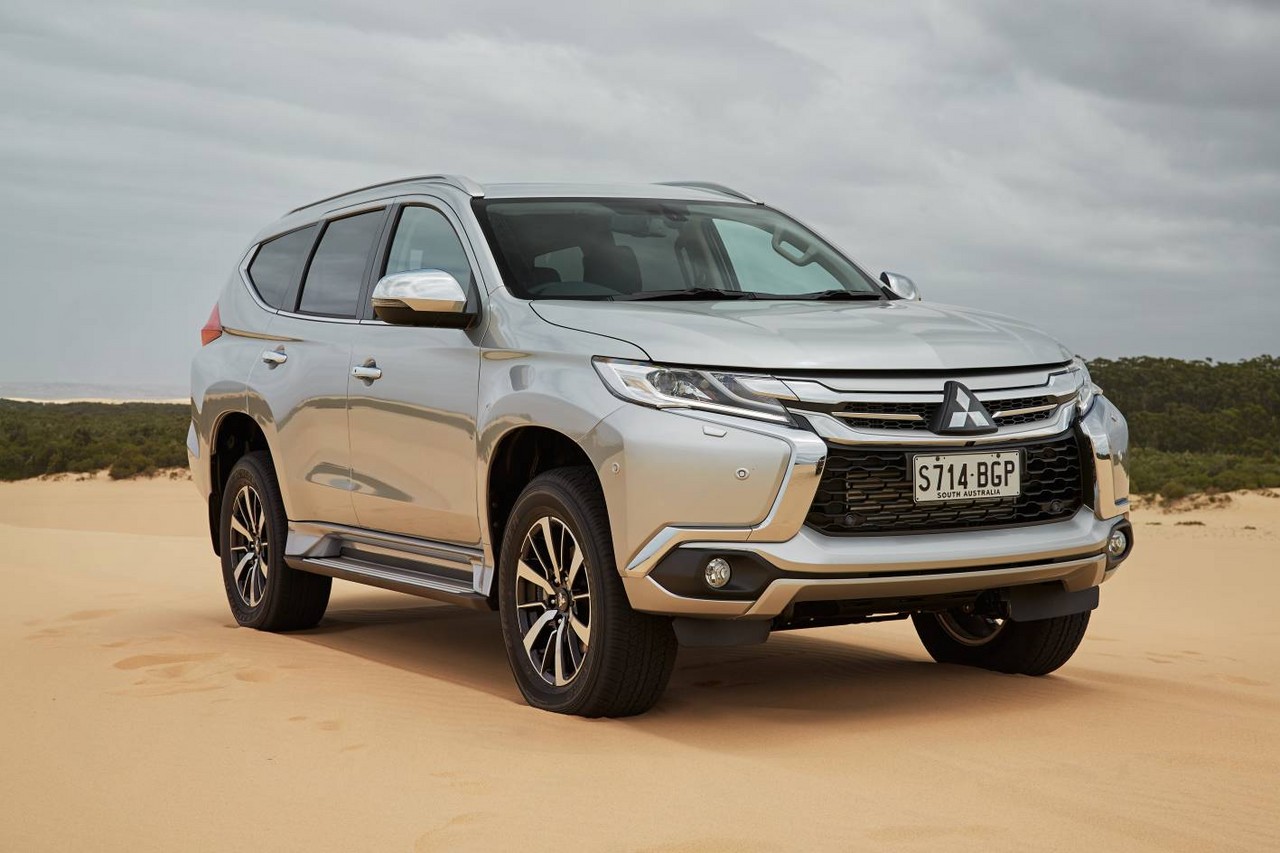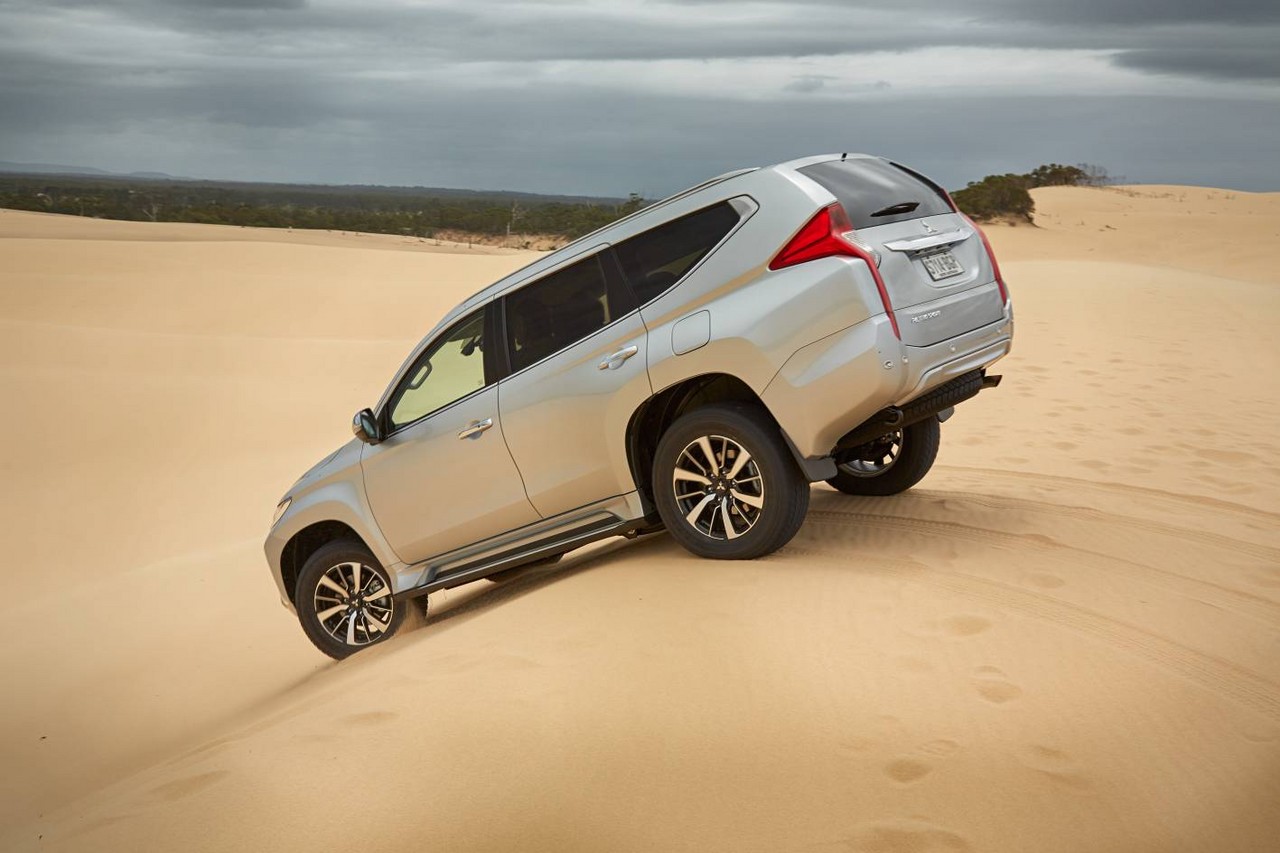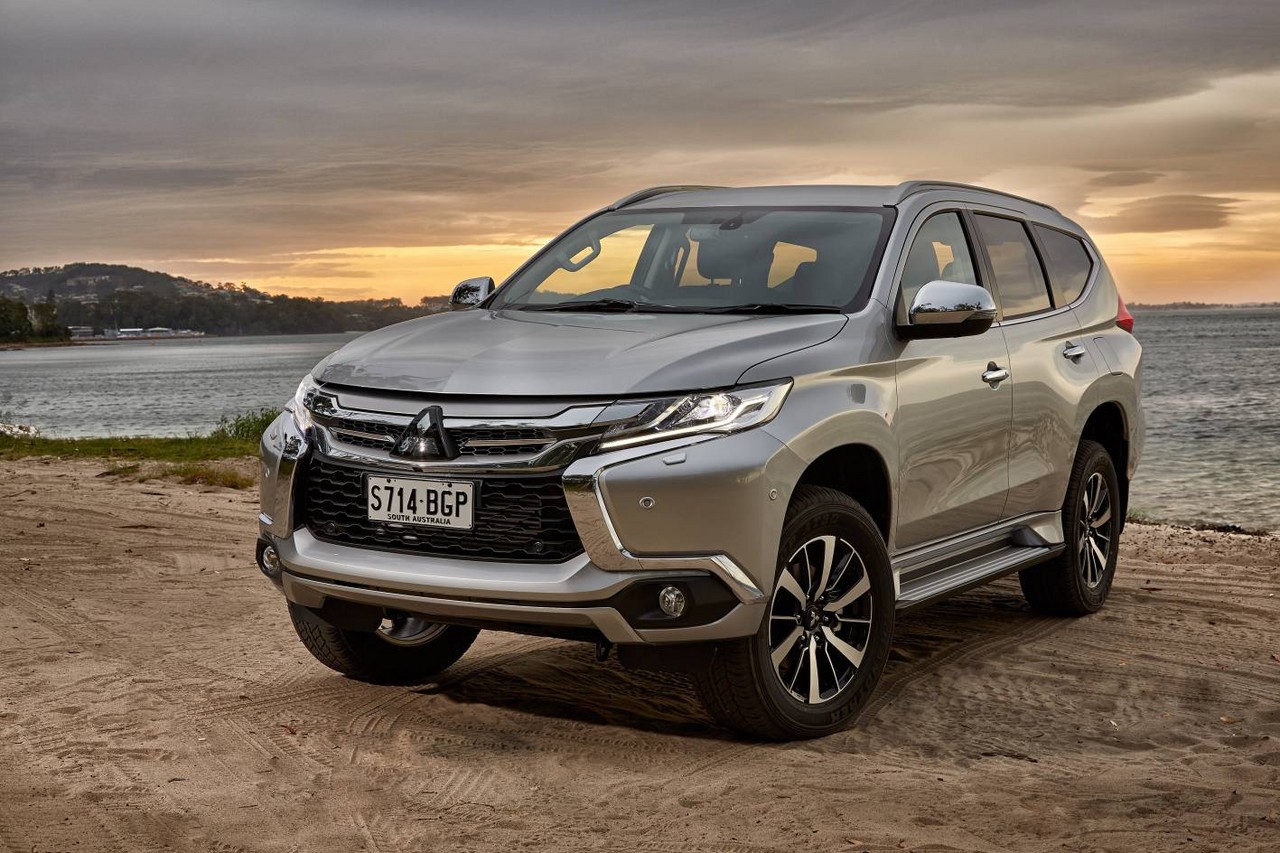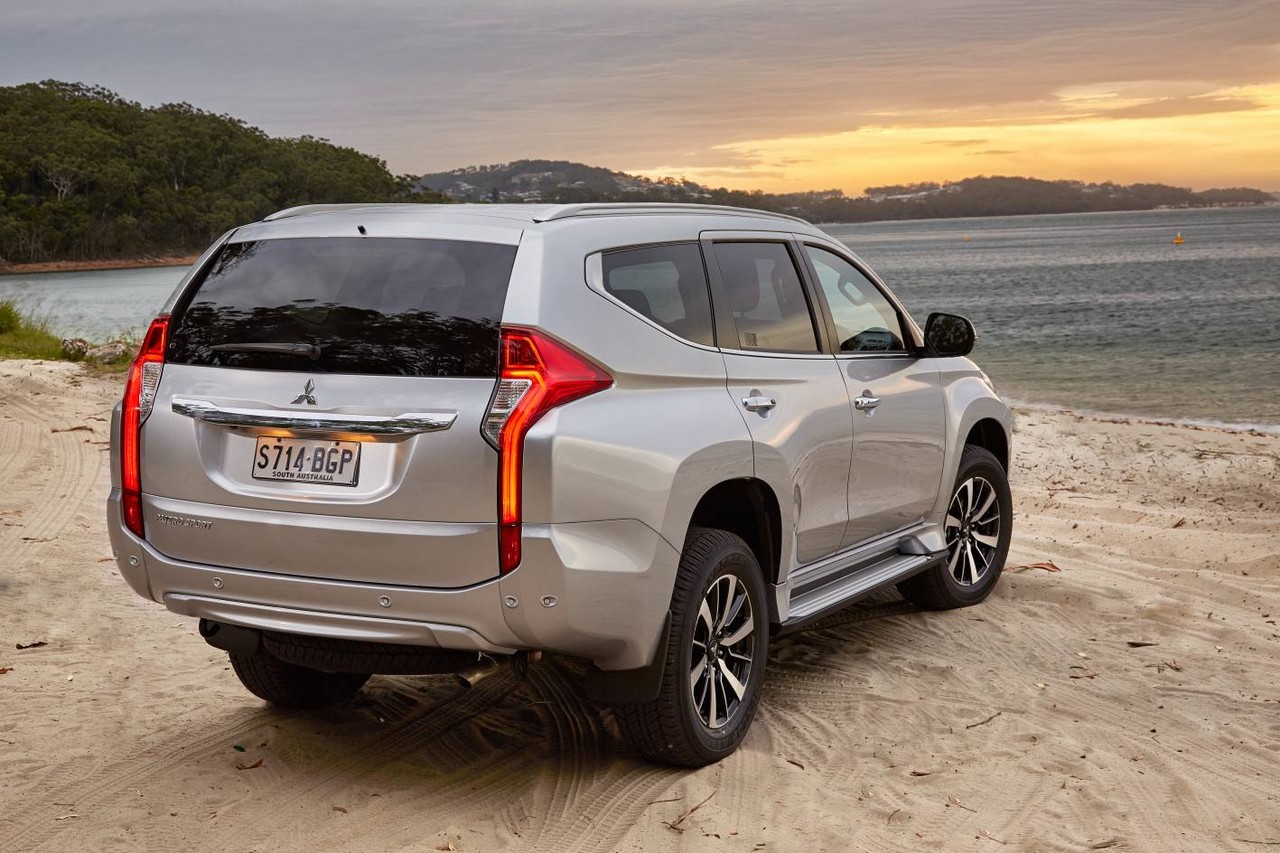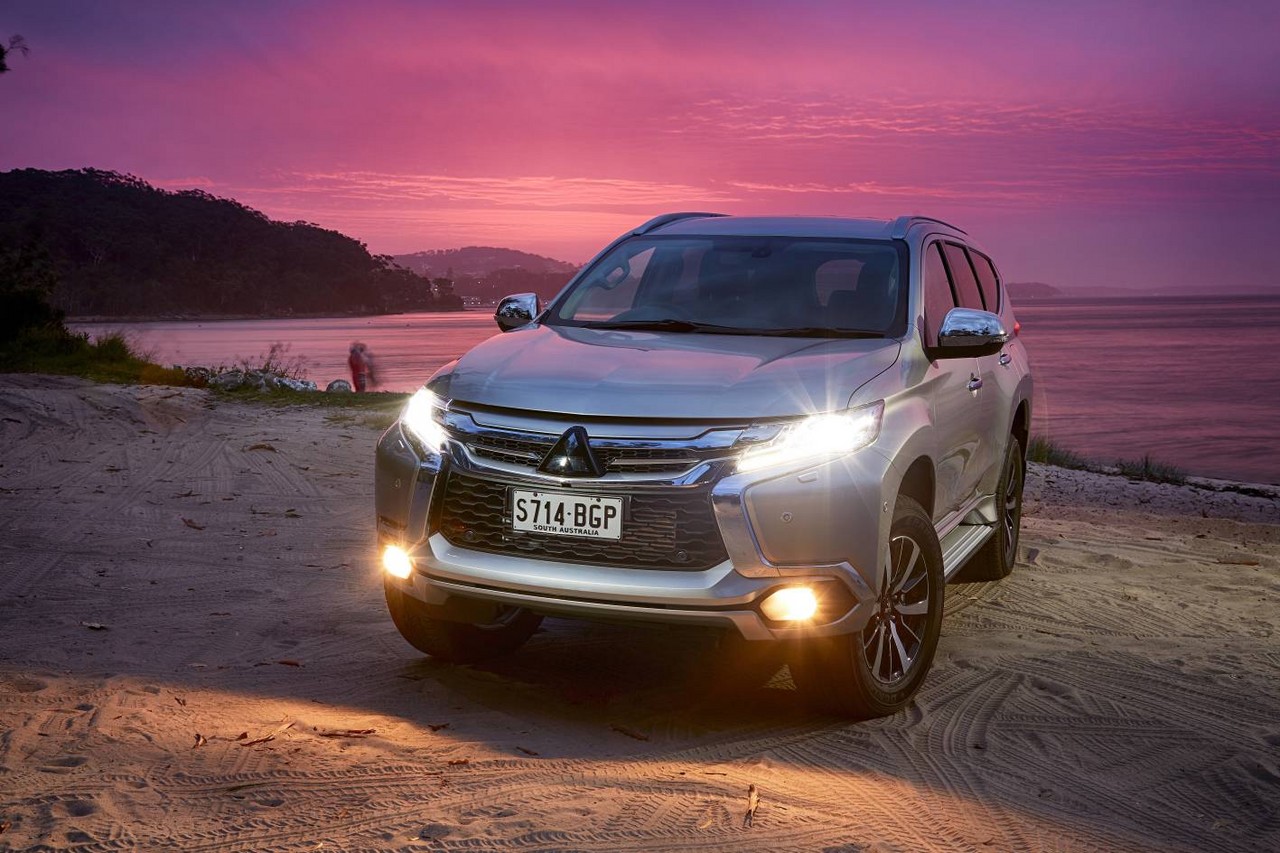
- Comfortable ride
- Quiet 2.4-litre diesel engine
- Refined and intuitive eight-speed automatic transmission
- Super Select II 4WD system provides off-road ability (though only GLS and Exceed have rear diff lock)
- Slight turbo lag when accelerating from low engine speeds
- Vague steering and steering wheel kickback over bumps
- Body roll when cornering
- Engine lacks grunt for towing
- Limited cabin space for front and third row occupants
- Limited luggage space with third row seats upright (131 litres)
Overview
Released in Australia in December 2015, the Mitsubishi QE Pajero Sport was four-wheel drive SUV. Manufactured in Laem Chabang, Thailand, the Mitsubishi Pajero Sport was powered by a 2.4-litre turbo-diesel engine that was mated to an eight-speed automatic transmission. Furthermore, the Pajero Sport range consisted of GLX, GLS and Exceed variants.
Initially, the Mitsubishi Pajero Sport GLX, GLS and Exceed variants were solely available with five seats. However,
- The Pajero Sport GLS and Exceed variants were fitted with seven seats as standard from July 2016; and,
- The Pajero Sport GLS was again available with five seats from April 2018.
For the seven-seat models, the 60:40 split second row seats could be folded and tumbled to provide access to the third row box, while a cargo box was fitted under the floor behind the third row seats for additional storage.
4N15 diesel engine
The 2442 cc 4N15 diesel engine had a die-cast aluminium cylinder block and head, double overhead camshafts (with a maintenance-free timing chain), four valves per cylinder, common-rail injection via piezo injectors at a pressure of up to 200 bar, a variable geometry turbocharger, a compression ratio of 15.5:1 and diesel particulate filter (DPF). The 4N15 engine also had Mitsubishi’s ‘MIVEC’ system which provides two-step control of intake valve timing and lift.
Over the combined ADR 81/02 test cycle, fuel consumption for the Mitsubishi Pajero Sport was 8.0 litres per 100 km. Furthermore, the Mitsubishi Pajero Sport complied with Euro 5 emissions standards.
| Variant | Engine | Trans. | Peak power | Peak torque |
|---|---|---|---|---|
| GLX, GLS, Exceed |
2.4-litre turbo-diesel I4 | 8sp auto | 133 kW at 3500 rpm | 430 Nm at 2500 rpm |
‘Super Select II’ 4WD system
The Mitsubishi Pajero Sport was fitted with Mitsubishi’s ‘Super Select II’ four-wheel drive system. AustralianCar.Reviews understands that this system utilised a two-setting constant mesh torque transfer unit that included a centre differential, viscous coupling unit (VCU) and a front free-wheeling differential. As such, the driver was able to select from:
- 2H: rear-wheel drive with high-range gearing;
- 4H: four-wheel drive with high-range gearing and a default 40:60 front:rear torque split;
- 4HLc: high range gearing with a locked centre differential for fixed four-wheel drive; and,
- 4LLc: low range gearing with a locked centre differential for fixed four-wheel drive.
Although omitted from the Pajero Sport GLX, both the Pajero Sport GLS and Exceed had a rear differential lock.
Using a selector dial in the centre console, the driver could select from four drive modes:
- Gravel: permitted the optimum amount of wheel slip for maximum traction and mid-corner stability;
- Mud/snow: controlled wheel slip to maintain momentum in slippery conditions by moderating throttle input and maintaining wheel movement with reduced intervention of the traction control system;
- Sand: allowed gentle movement of the wheels when accelerating in sandy conditions. Sand mode tended to rely on the traction control system’s limited slip differential (LSD) to maintain traction, while employing a unique gearshift pattern and the low-range gears; and,
- Rock: reduced wheel slip by using the limited slip differential when one or more wheels were not in contact with the ground or when climbing steep gradients. Like Sand mode, Rock mode also used the low-range gears.
For steep descents, the Hill Descent Control system could maintain a constant speed within the range of 2 km/h to 20 km/h by automatically applying the brakes so that the driver could focus on steering the vehicle. The Pajero Sport also had a Hill Start Assist function.
Dimensions
Relative to the Mitsubishi Mk.2 Challenger which it replaced, the Pajero Sport was 90 mm longer (at 4785 mm) and 35 mm lower (1805 mm), but width (1815 mm) and wheelbase length (2800 mm) were unchanged; its drag coefficient was 0.40 Cd. The body of the Pajero Sport, however, has a greater proportion of high-tensile steel plates for a lighter and stiffer body. As such, kerb weight for the Pajero Sport ranged from 2045 kg (for the Pajero Sport GLX) to 2070 kg (for the Pajero Sport Exceed).
The Mitsubishi Pajero Sport has ground clearance of 218 mm, an approach angle of 30 degrees, ramp break-over angle of 23.1 degrees and departure angle of 24.2 degrees. Furthermore, wading depth for the Pajero Sport is 700 mm.
The Mitsubishi Pajero Sport had a braked towing capacity of 3100 kg.
Suspension
The Mitsubishi Pajero Sport had double wishbone front suspension and a three-link live rear axle, both with coil springs and stabiliser bars. Relative to the Mk.2 Challenger, changes for the Pajero Sport included a thicker front sway bar to reduce body roll, while front and rear damper rates were reduced for greater ride quality. For the rear suspension, mount positions and the structure of the lateral rod mounts was revised for greater stability.
Safety equipment
Standard safety equipment for the Mitsubishi Pajero Sport included dual front airbags, a driver’s knee airbag, front seat-mounted side airbags, full-length curtain airbags, ABS, electronic brake force distribution, electronic stability control (including trailer stability assist), traction control and front seatbelts with pretensioners and load limiters.
The Mitsubishi Pajero Sport Exceed was further equipped with:
- Forward Collision Mitigation (FCM): used a millimetre wave radar mounted in the grille to obstacles ahead. If the distance to a detected obstacle decreased such that there was a risk of collision, a warning alarm would sound, followed by autonomous application of the brakes to avoid or reduce the severity of a collision;
- Blind Spot Warning (BSW): used ultrasound sensors in the rear bumper to detect vehicles as they approached the driver’s blind spot. The driver was then warned by an audible alert and an illuminated symbol in the driver’s door mirror;
- Ultrasonic misacceleration Mitigation System (UMS): used ultrasonic sensors to detect obstructions in front of and behind the vehicle and could regulate engine power. The UMS used this information to reduce the likelihood and severity of collisions when the driver mistakenly pressed the accelerator when stationary or at speeds up to 10 km/h and issued an audible warning; and,
- Multi-around view Monitor System (MMS): used four cameras to generate and display a bird;s eye view of the vehicle’s perimeter to assist the driver when reversing or parking.
In April 2018, standard safety equipment for the Mitsubishi Pajero Sport was extended to include:
- Forward Collision Mitigation (FCM, see above); and,
- Adaptive Cruise Control (ACC): when cruise control was active, ACC used a 77 GHz millimetre-wave radar to monitor the distance to the vehicle ahead could apply the brakes to maintain a safe distance to the vehicle ahead; when safe to do so, the vehicle would automatically accelerate to its previously selected cruising speed. Furthermore, the vehicle could brake until it is stationary and a touch of the accelerator or flick of a switch would cause the vehicle to accelerate when the vehicle ahead started moving (‘stop-go traffic functionality’).
ANCAP crash testing
In ANCAP crash testing , the Mitsubishi Pajero Sport received a five star adult occupant protection rating. In the frontal offset test, protection of the front passengers was generally rated as good, though protection of the driver’s chest and lower legs was rated as adequate (i.e. a slight risk of serious injury).
Brakes
The Mitsubishi Pajero Sport had 320 mm ventilated front brake discs with two-piston calipers and 315 mm ventilated rear brake discs.
Features: Mitsubishi Pajero Sport GLX
Standard features for the Mitsubishi Pajero Sport GLX incuded 18 x 7.5J two-tone alloy wheels with 265/60 R18 110H tyres, a four speaker sound system with digital radio (DAB), Bluetooth mobile phone connectivity and audio streaming with voice control, cloth seats, climate control air conditioning, cruise control, LED headlights, LED daytime running lights, front fog lights, rear parking sensors, a rear view camera, 60:40 split and folding rear seats, a leather-wrapped steering wheel with gearshift paddles, remote central locking with proximity key (i.e. keyless entry), push-button start, tilt and telescopic steering wheel adjustment, a height adjustable driver’s seat, power adjustable and folding door mirrors, power windows, two 12 volt power outlets, an electric park brake, privacy glass, side steps, silver roof rails, a trip computer, an alarm and immobiliser.
As standard, the Mitsubishi Pajero Sport had a ‘Smartphone Link Display Audio’ (SDA) system which includes a seven-inch touchscreen and is compatible with Android Auto and Apple CarPlay. The system allows users to connect to apps or other features of their phone through the touchscreen or via voice control. The SDA system also had two USB inputs and an HDMI input.
The Pajero Sport was also equipped with an Electronic Time and Alarm Control System which has a number of fully customisable functions including welcome light, coming home light, rear wiper, folding door mirrors and, for the Pajero Sport GLS and Exceed, light-sensitive headlight settings.
Features: Mitsubishi Pajero Sport GLS and Exceed
Relative to the GLX, the Pajero Sport GLS was further equipped with a six speaker sound system, leather seats, dual-zone climate control air conditioning, automatic headlights, rain-sensing wipers, an electrochromatic rear view mirror and cargo cover.
The range-topping Pajero Sport Exceed was distinguished by its eight speaker sound system, heated front seats, headlight wasters, a rear seat entertainment unit with a DVD player, nine-inch HD colour display and two headphone sets.
April 2018 update
As noted above, the Mitsubishi Pajero Sport range was updated in April 2018 with the introduction of a five-seat GLS variant and standard fitment of Forward Collision Mitigation (FCM) and Adaptive Cruise Control (ACC). Beyond this, however, the interior underwent the following changes:
- Two new USB ports were introduced for second row occupants (in addition to the two existing USB outlets in the centre console bin);
- The existing 120 watt accessory socket was relocated to the rear of the centre console;
- A new 150 watt/220 volt three-pin auxiliary outlet was introduced;
- Illuminated vanity mirrors were fitted as standard; and,
- Soft trim was fitted along the sides of the centre console.
Visual changes for the post-April 2018 Mitsubishi Pajero Sport were limited to a new alloy design for the Pajero Sport GLX and fitment of a tailgate spoiler for the Pajero Sport Exceed.
Paint colours
The Mitsubishi Pajero Sport was available in the following paint finishes:
- White;
- Deep Metallic Brown;
- Titanium Grey Metallic;
- Black Mica;
- Silver Metallic; and,
- Medium Red Mica.
The metallic and mica finishes had an additional retail cost of $550.
Brochure and specifications
- Brochure: Mitsubishi Pajero Sport (December 2015)
- Specifications: Mitsubishi Pajero Sport (December 2015)
Related links

